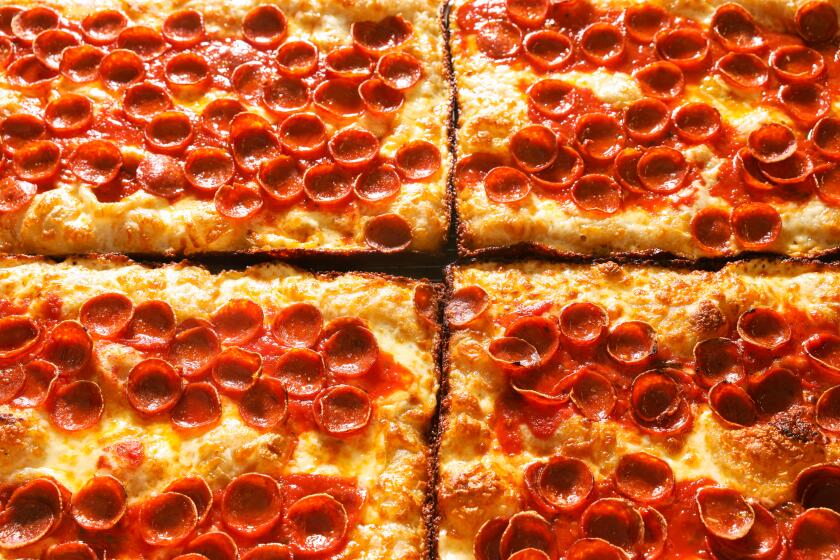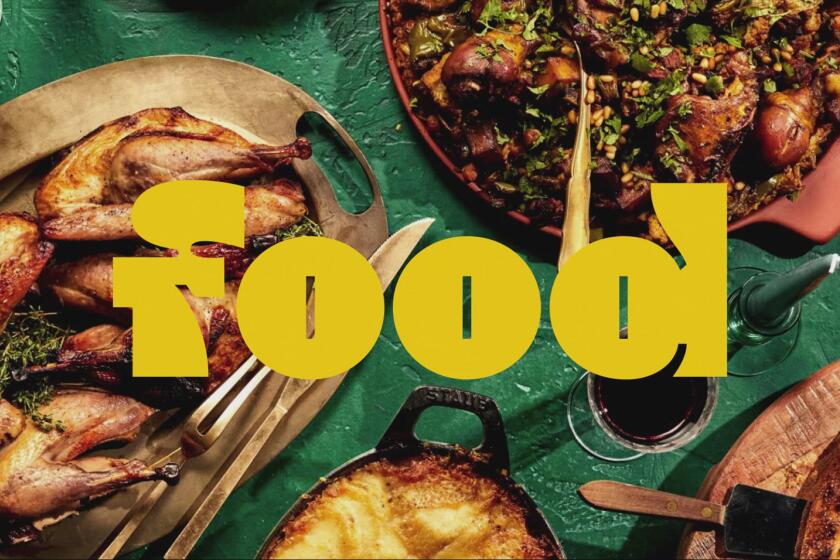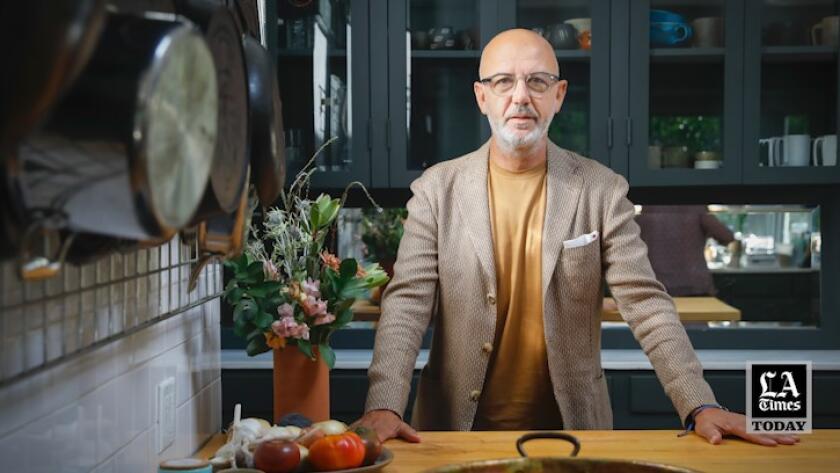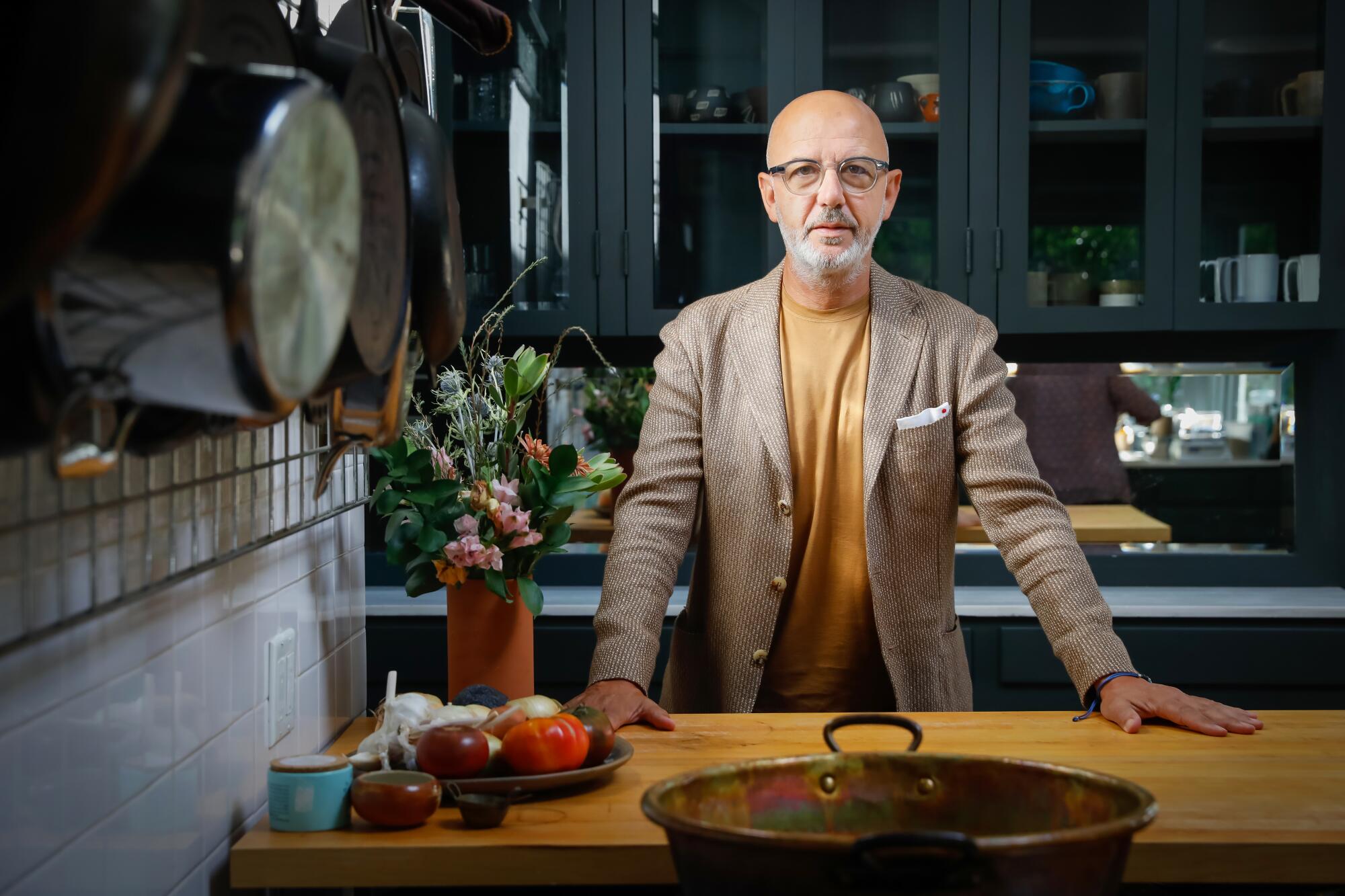
- Share via
Any discussion of the pizza of Italy’s Franco Pepe begins with the dough. Made entirely by hand, without even a mixer, the dough at his restaurant, Pepe in Grani, about 30 miles north of Naples, comes together in traditional madia boxes, their unvarnished pine sides slanted outward to help the mixing and kneading of flour, water and live yeast from his years-old starter. The dough then rests covered in these wooden boxes and ferments. When the lid comes off, one of the most beautiful living substances in all of food is revealed.
Just check out the recent Pepe episode of Netflix’s “Chef’s Table: Pizza,” which begins with shots of the dough in slow motion, oozing with bubbles like L.A.’s seething La Brea Tar Pits. It’s no surprise that “artisan” is a descriptor frequently associated with Pepe, whose wood-fired pizzas are topped almost exclusively with ingredients grown and produced in the countryside surrounding Caiazzo, the city where the restaurant sits.
“When I opened my pizzeria, I swore to myself that I’d put my region on my pizza,” he says in the “Chef’s Table” episode, speaking like a true Slow Food hero.
Indeed, Pepe in Grani was named the world’s best pizzeria three years in a row (2017 through 2019) by the 50 Top Pizza guide, leading the way for other innovators such as Francesco Martucci’s I Masanielli in nearby Caserta. And in September, for the second consecutive year, Pepe was named the world’s best pizza chef in the Best Chef Awards.
Bill Addison breaks down his top 10 favorite new pizzerias so far in 2022.
So what is this artisan pizza chef doing in Los Angeles talking about electric ovens and dehydrators? Why has he been spending time with nutritionists? And why did he give a speech in Madrid this past fall to discuss the ways science can help lead the way toward the future of pizza?
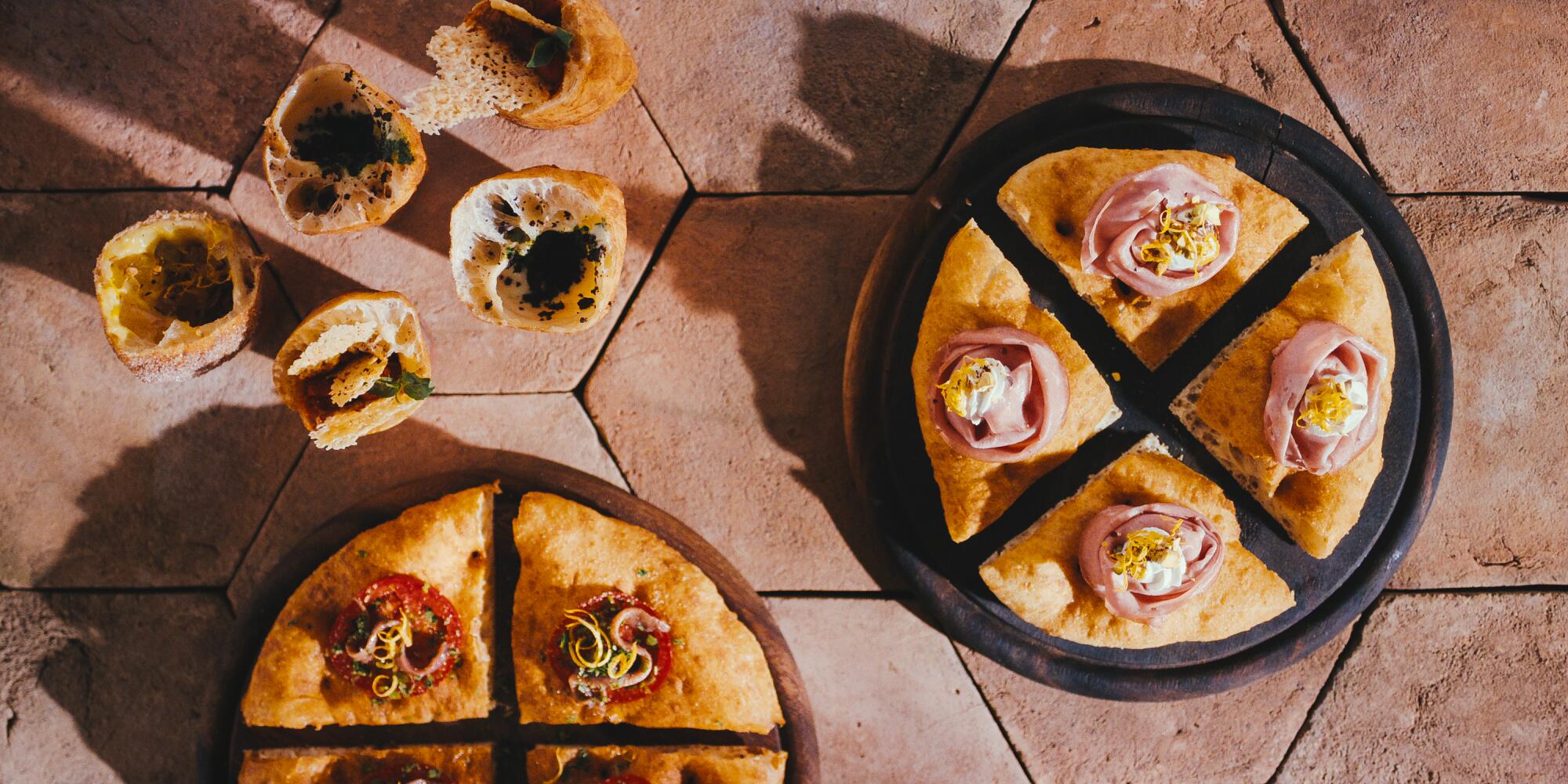
“I’m always challenging myself,” Pepe says through a translator after a photo shoot inside the L.A. home of “Chef’s Table” executive producer and director Brian McGinn. One recent challenge: to restore the reputation of the now-out-of-favor pizza capricciosa. In the 1970s and ’80s pizza capricciosa was one of Italy’s most popular dishes. Today, it’s considered an old-fashioned pizza, an empty-the-refrigerator pie weighed down with too many toppings — artichokes, mushrooms, olives, prosciutto cotto, tomatoes, mozzarella, basil and sometimes capers and anchovies — basically, a less organized version of a quattro stagioni.
“The pizza maker would just put everything on the dough and throw it in the oven,” Pepe says. “It was too much.” Often, even the fresh herbs would go into the oven and lose their vitality.
Pepe also noticed that the pizza frequently was soggy in the middle. That’s because most of the ingredients contain large percentages of water — olives, he says, are 70% water; tomatoes, 95%; mozzarella, 58%.
“My idea was to transform these ingredients,” Pepe says, “and also to separate them because they have different cooking times.”
This is where the dehydrator comes in. He uses the machine to turn tomato sauce into flavor-packed tomato sheets (a more delicate version of fruit leather) and dries the olives and capers into rough powders. The mushrooms are dusted with flour and deep-fried. The basil is pureed with olive oil and ice cubes (to preserve the color). The only ingredients baked in the oven with the dough are the mozzarella, the artichokes and the prosciutto cotto. After the pizza is cooked, Pepe places torn bits of the tomato sheets on top, then sprinkles on the dehydrated olives and capers plus oregano, fried mushrooms, drops of oil from strained anchovies and dots of the basil puree.
“Dignity is given back to the pizza,” he says.
It all sounds good, yet for those of us who came of age at a time when chefs were rejecting processed foods in favor of seasonal, locally grown ingredients presented as simply as possible, it’s disconcerting at first to hear about Pepe’s explorations. Especially when he opens a computer and plays a video demonstrating his old and new pizza capricciosa. Pepe’s old-style capricciosa looks pretty tasty in the video — it’s impossible for him to make a bad-looking pizza. The first segment ends with a lovely shot of wood aflame in a pizza oven. Then as the focus shifts to his new capricciosa, the romantic wood fire image changes to a shot of an electric pizza oven being switched on with the press of a button.
From Times editors Laurie Ochoa and Daniel Hernandez: There’s no better place or moment for eating and cooking than in Los Angeles right now.
Does this mean Pepe is rejecting the tradition of wood-fueled pizza ovens?
“For me,” Pepe says, “after the wood-fired oven, the electric oven is next. It’s the ideal alternative.”
But he’s not giving up his wood-burning oven just yet. It’s true that he’s started working with an electric oven, open in the front and dome-shaped like a traditional pizza oven, which can reach 500 degrees Celsius (that’s 942 degrees Fahrenheit) in about an hour. For now, however, the electric oven is something Pepe uses on the road to spread the gospel of pizza, as well as a tool he envisions for home use.
He also likes that electric ovens are better for the environment. And given that more and more places in the world are phasing out wood- and gas-powered stoves — consider last year’s Los Angeles City Council ban on gas appliances in new homes and commercial buildings — the next generation of pizza chefs will need artisans like Pepe to figure out how to work with electric ovens.
“We want to use technology and innovation,” Pepe says, “but we shouldn’t lose the ability to hand-make food. We shouldn’t forget our own technology as humans. So many times we let technology come into our life and we ignore ourselves. We cancel ourselves.”
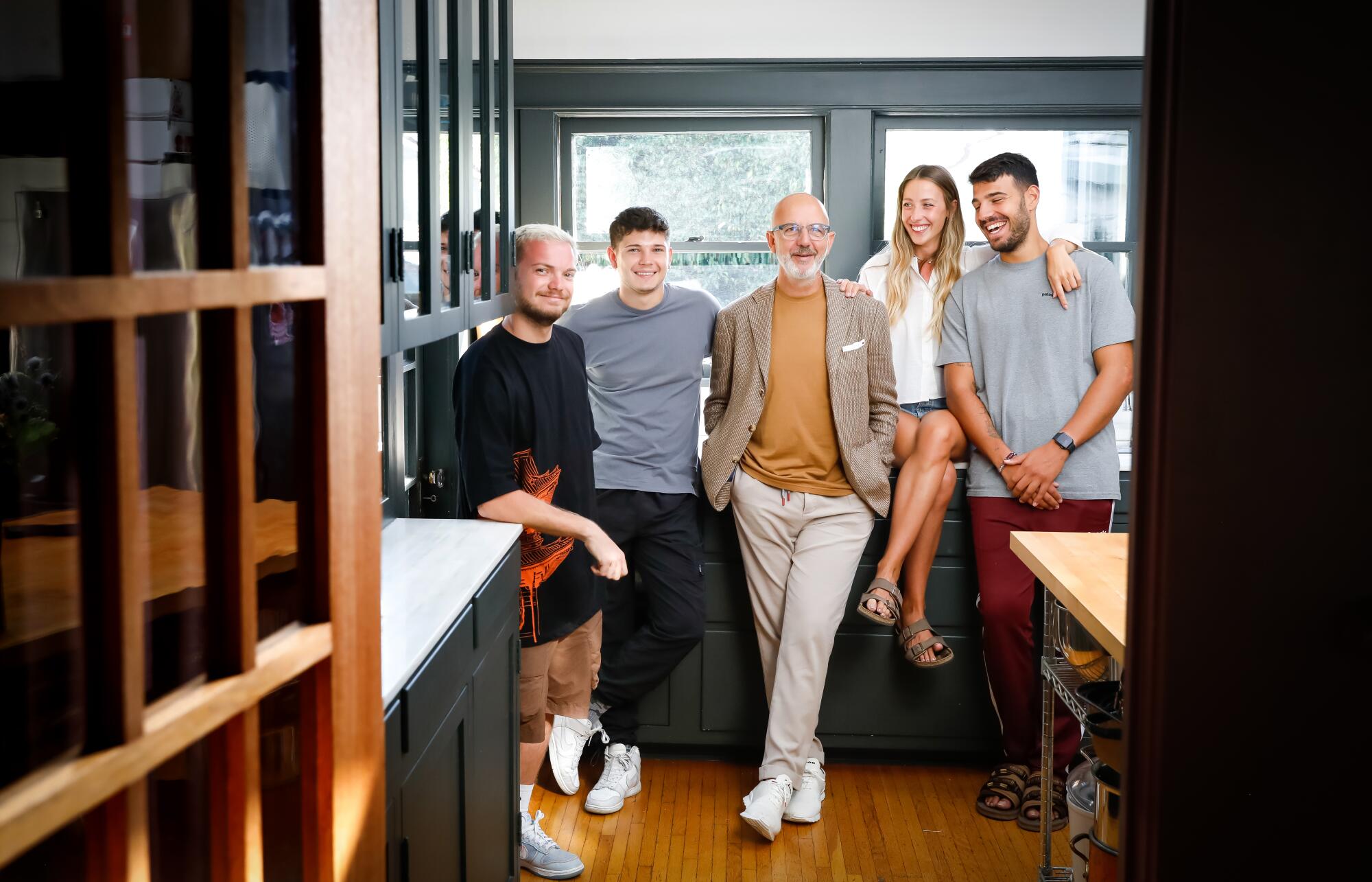
Pepe has always blended innovation with artisan tradition. His most famous early pizza, the Margherita sbagliata, or “mistaken margherita,” brings a chef’s ingenuity to a classic recipe that few would have dared to change 10 years ago when Pepe opened his restaurant.
“Italians figure their classic dishes don’t need to be messed with,” says Italy-based food writer and early Pepe advocate Faith Willinger in the “Chef’s Table” episode. “I mean, it’s considered a sin.”
But Pepe felt that two of the star ingredients on a Margherita, the basil and tomatoes, weren’t being treated with the dignity they deserved. “Why put a fantastic tomato in an oven at 400 degrees [Celsius, 752 degrees Fahrenheit]?” he says in “Chef’s Table.” “Then I thought about the basil leaf. Many people don’t eat it. They discard it. So I created this reduction of basil and local oil.”
Only mozzarella and olive oil are put on the dough before Pepe’s Margherita is baked. Then his pizza makers use squeeze bottles to form red geometric lines of tomato passata and dots of basil reduction on top of the melted cheese. The pizza looks like a modernist piece of art when it arrives at the table.
Of course, squeeze bottles — and, for that matter, dehydrated sheets of tomatoes for the capricciosa pizza — may not seem like the expected tools of an artisan pizza chef. But when you taste Pepe’s pizza you understand.
I first ate Pepe’s pizza in late 2013, a little more than a year after he broke away from his family’s traditional pizzeria in Caiazzo and opened his own restaurant a five-minute walk away. I’d gone there with the late Jonathan Gold (who was my husband and this paper’s restaurant critic) to meet Mozza chef and restaurateur Nancy Silverton, who had eaten at Pepe in Grani a few months earlier and declared its pizza the best she’d ever eaten.
“It feels almost as if Franco invented pizza and everyone else is just copying him,” she told Jonathan for a 2014 Food & Wine story he wrote about Pepe. “It’s like chefs doing molecular cuisine after Ferran Adrià at El Bulli.”

What struck me at the time was the way this single pizzeria — which makes up to 1,000 pizzas nightly for crowds that in non-COVID times can wait hours for a table — supports a whole ecosystem of local farmers and producers. Piennolo tomatoes and apricots are grown on the sides of Mt. Vesuvius just more than an hour’s drive away. And we saw bufala mozzarella being made for Pepe just down the road from Caiazzo. I also fell in love with Pepe’s no-machine dough-making skill, which results in a crust that is light to the touch — pull a piece off the edge to experience its elasticity — but so substantial in flavor that you can practically taste the time that went into making it.
It’s easy to get so caught up in the craftsmanship of the handmade dough and intense flavors of the local produce on top of the pizza that you might forget to notice the more modern innovations Pepe has brought to the world of pizza.
Even here in California, where pizza has undergone multiple transformations, we haven’t seen pizza like Pepe’s. He was an early proponent of the pizza tasting menus that have popped up around Italy, and designed a tasting-room table with a view through the center of the table to the kitchen below.
He’s also reworked the concept of Naples’ fried pizza into something lighter — a cone of airy fried dough filled with melted cheese, arugula pesto and a dusting of flavorful dehydrated olives or rounds of puffy fried dough divided into four pieces, each unsauced but artfully topped with a floret of thinly sliced mortadella, a dab of bufala ricotta and threads of lemon zest.
“It’s like eating a cloud,” Silverton says of Pepe’s fried pizza in the “Chef’s Table” episode.
Lately, Pepe’s been working with a nutritionist to come up with a collection of pizzas that are healthier and easier to digest, with fewer carbohydrates than a typical pizza. So it shouldn’t have come as a surprise that Pepe is experimenting with electric ovens and other technology.
It’s all part of his quest to elevate the standing of pizza in the world of cuisine while preserving its populist roots and artisan traditions. It’s a balancing act he’s worked hard to maintain while setting a course for pizza’s future. But for all his talk about technology and innovation, Pepe, like a true chef, knows there is one thing that matters above all else for pizza lovers around the world.
“For me,” he says firmly, “there is one universal language. Flavor.”

- Share via
Watch L.A. Times Today at 7 p.m. on Spectrum News 1 on Channel 1 or live stream on the Spectrum News App. Palos Verdes Peninsula and Orange County viewers can watch on Cox Systems on channel 99.
More to Read
Eat your way across L.A.
Get our weekly Tasting Notes newsletter for reviews, news and more.
You may occasionally receive promotional content from the Los Angeles Times.
